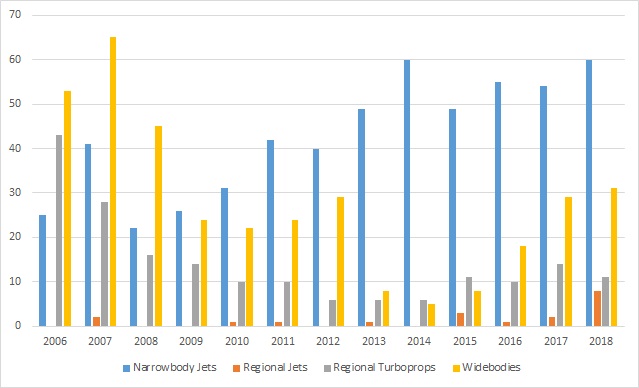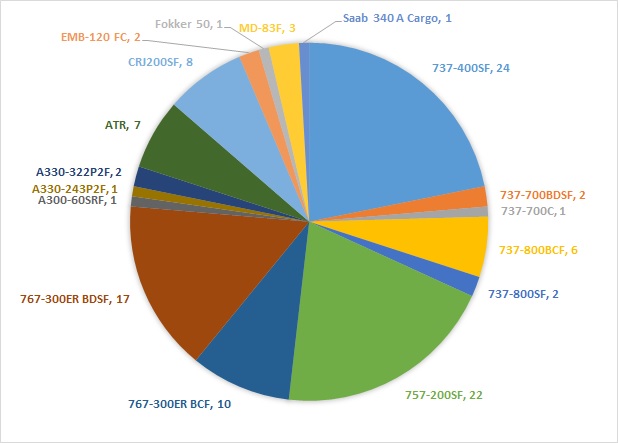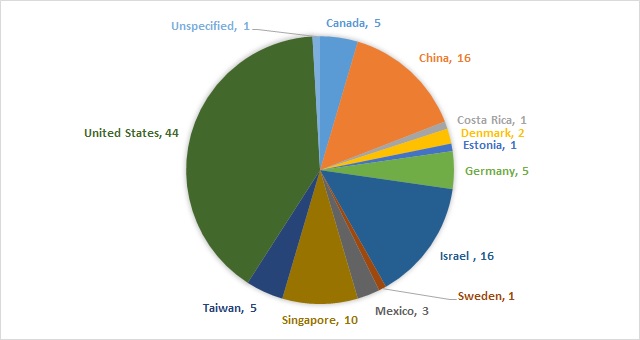Freighter conversions rose 11% in 2018, with widebody conversions hitting their highest level since 2008.
Flight Fleets Analyzer shows that 2018 saw a total of 110 commercial aircraft converted to freighters, up from 99 in 2017 and 84 in 2016.
Widebody conversions rose by two units to 31 aircraft. The Boeing 767-300ER dominated widebody conversions by a considerable margin, with 27 aircraft converted to freighters. Of these, 17 were converted to the -300ER BDSF (Bedek-designed special freighter) standard, and 10 to the -300ER BCF (Boeing converted freighter) standard.
Annual freighter conversions

All data Flight Fleets Analyzer
Of the 17 BDSF conversions, 14 took place at IAI Bedek’s facility in Tel Aviv, and three in Mexico City, where IAI Bedek and Mexicana operate a joint facility. The 10 -300ER BCF conversions were equally divided between Evergreen Aviation Technologies in Taipei Taoyuan and ST Engineering Aerospace in Singapore.
The other four widebodies converted comprised a pair of A330-300 P2Fs, an A330-200 P2F and an A300-600RF.
The biggest recipient of converted widebodies was Amazon’s Prime Air unit, which took eight converted 767s – four -300ER BCFs and four -300ER BDSFs. This is down from the 16 converted 767s the carrier took in 2017. Cargojet Airways, Kalitta Air and UPS also received three converted 767s each.
Chris Seymour, head of market analysis at Flight Ascend Consultancy, says that strong 767 conversions were a major theme during the year, and that this is likely to continue in 2019.
2018 Freighter conversions by type

The A330 conversions went to Air Hong Kong, EFW and Egypt Air, while China’s Uni-Top Airlines took the A300-600RF.
Flight Fleets Analyzer shows that there were no 747 conversions in 2018.
Narrowbody conversions also grew, rising to 60 aircraft, up from 54 in 2017. The 737 led with 35 examples, followed by 22 757-200s and three MD-80s. Of the 35 737s converted, 24 were 737-400SFs. In addition, three 737-700s and eight 737-800s were converted.
Seymour says that feedstock for 737 “Classic” and 757s held up in 2018, but that conversions for older 737s fell to 17 from 29 in 2017, and that feedstock is “definitely on the wane". This, however, will be offset by the growth in 737NG conversions.
The biggest recipient of converted narrowbodies was China’s SF Airlines, a unit of China cargo firm SF Express, which took eight 757-200SFs during 2018. ASL Airlines Belgium took seven converted 737s, five -400SFs and two -800BCFs, while DHL Air took six 757-200Fs.
2018 freighter conversions by country

The year saw strong growth in regional jet conversions with eight CRJ200s converted to freighters, compared to just two regional jet conversions in 2017.
The conversion space for turboprops declined marginally to 11 aircraft from 14 a year earlier. The year saw seven ATRs (six ATR 72s and one ATR 42) converted to freighters, as well as two Embraer E-120s, a Fokker 50 and a Saab 340.
“The outlook for coming year also looks good – we have identified at least 76 conversions lined up already and likely more as the year progresses,” adds Seymour. “Whether we match 2018’s total is likely to hinge on the numbers of 757s and Classics converting.”
In addition, he adds that 2019 will see the arrival of the first A321P2Fs, and that there are five conversion programmes available for the type – although he does not expect all of these to come to fruition.
“The A321P2F also looks like a good bridge between the 737 Classic and 757,” he says.
Source: Cirium Dashboard


























